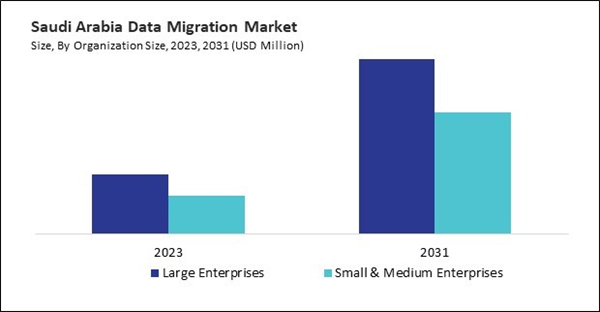The Brazil market dominated the LAMEA Data Migration Market by country in 2023, and is expected to continue to be a dominant market till 2031; thereby, achieving a market value of $812.3 million by 2031. The Argentina market is showcasing a CAGR of 14.7% during 2024-2031. Additionally, the UAE market would register a CAGR of 12.7% during 2024-2031.
Real-time data migration is becoming increasingly critical as businesses generate more data. In the finance, logistics, and cybersecurity sectors, organizations rely on real-time data processing to detect fraud, optimize supply chain operations, and enhance threat detection. Financial institutions, for example, require real-time transaction data migration to ensure fraud detection algorithms remain accurate and up-to-date. In a comparable manner, manufacturing enterprises utilize data migration facilitated by the Internet of Things (IoT) to oversee equipment performance and anticipate maintenance requirements prior to the occurrence of defects. These real-time data migration requirements drive advancements in AI-powered data streaming technologies that enable continuous and secure data movement across platforms.
Furthermore, the emergence of low-code and no-code migration solutions democratizes data migration by enabling non-technical users to easily handle data transfers. Traditionally, data migration required significant technical expertise, making it a resource-intensive process. However, modern low-code platforms offer intuitive interfaces, drag-and-drop functionality, and AI-assisted recommendations that simplify migration tasks. Businesses that lack dedicated IT teams can now execute migration projects efficiently without the need for extensive programming knowledge. This trend particularly benefits small and medium-sized enterprises (SMEs) looking to adopt cloud technologies without incurring high migration costs.
The market in Brazil, Latin America’s largest economy, is also experiencing rapid growth, driven by the expansion of cloud services, fintech investments, and AI-driven digital transformation. Government-led programs such as the Emerging Brazilian Artificial Intelligence Strategy (EBIA) and the General Data Protection Law (LGPD) emphasize secure and compliant data handling as organizations transition to cloud-based systems. The Brazilian Strategy for Digital Transformation (E-Digital) also focuses on enhancing internet connectivity and strengthening data infrastructure, further driving the demand for seamless data migration solutions. As industries across Brazil embrace cloud computing, AI-powered analytics, and automation, the need for secure, high-performance data transfer solutions has grown significantly. Therefore, with the region’s growing reliance on hybrid cloud environments, AI-driven automation, and digital transformation initiatives, LAMEA presents lucrative opportunities for the data migration market.
List of Key Companies Profiled
- Oracle Corporation
- IBM Corporation
- Microsoft Corporation
- SAP SE
- SAS Institute Inc.
- Amazon Web Services, Inc. (Amazon.com, Inc.)
- Dell Technologies, Inc.
- Hewlett Packard Enterprise Company
- Fujitsu Limited
- Capgemini SE
Market Report Segmentation
By Organization Size
- Large Enterprises
- Small & Medium Enterprises
By Data Type
- Customer Data
- Financial Data
- Product Data
- Compliance Data
- Supplier Data
By Deployment Type
- Cloud
- On-Premise
By Business Function
- Sales & Marketing
- Finance
- Operations
- Human Resource
- Other Business Function
By Application
- BFSI
- Healthcare
- Manufacturing
- Retail
- Telecom & IT
- Energy & Utilities
- Media & Entertainment
- Other Application
By Country
- Brazil
- Argentina
- UAE
- Saudi Arabia
- South Africa
- Nigeria
- Rest of LAMEA
Table of Contents
Companies Mentioned
- Oracle Corporation
- IBM Corporation
- Microsoft Corporation
- SAP SE
- SAS Institute Inc.
- Amazon Web Services, Inc. (Amazon.com, Inc.)
- Dell Technologies, Inc.
- Hewlett Packard Enterprise Company
- Fujitsu Limited
- Capgemini SE
Methodology

LOADING...









